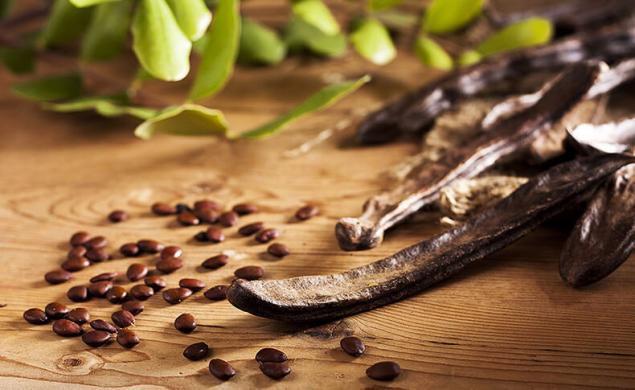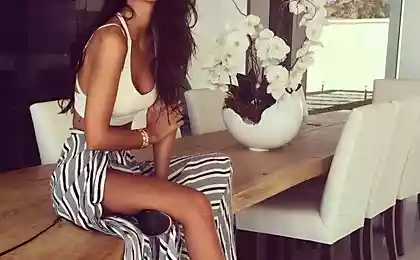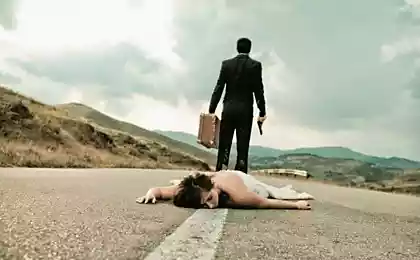1001
Carob - what it is and what it eats
Carob in appearance is little different from cocoa powder. The only difference in the shade of brown. To taste it is similar to cocoa and sugar. Carob is much sweeter than chocolate or cocoa, that is, it is not necessary to add sugar.
The essential difference in that carob does not contain psychotropic (psychoactive) substances. It is believed that it softens the gastro - intestinal tract and helps with diarrhea.
Carob - carob (locust beans, sweet pods, sweet horns) Sepatonia siliqua L.

Cladky "coffee" Carob powder is produced from the dried fruits (pods) of the subtropical evergreen plant of the legume family - carob.
Homeland consider carob Mediterranean countries, Spain, Italy, Cyprus and others.
The pods are inedible raw. The immaturity of their tear and lay in the sun, and then they made sweet.
Carob tree does not suffer from the disease sponge, it is not subject to disease, so it is not sprayed with chemical fertilizers. The tree begins to bear fruit regularly over 15 years.
In ancient Greece, the fruits of the carob tree was known as the "Egyptian figure". These solid smooth seeds have completely identical shape and weight, so that in antiquity they served as a measure of mass, under the Arabic name "CARAT". One carat equals 200 milligrams. This longitudinal unit of mass used to this day in the pharmaceutical and jewelry to determine the weight of precious stones, pearls, gold and diamonds. In some countries, "carat" is used to refer to the sample alloys of precious metals.
According to the Brockhaus and Efron Encyclopedic Dictionary (1901) Locust "Ioann the Baptist ate unto pustyn, because the Germans are called pods sladkie Johannisbrod,« bread
Ioanna. " The taste carob powder is a bit like cocoa powder, but very sweet. Carob is recommended as a substitute for cocoa and sugar (chocolate) diabetics and overweight people.

Useful properties and composition of the carob
Carob is very rich in natural dietary fibers which have a beneficial effect on the intestinal microflora.
Features Carob
Firstly, in contrast to the cocoa bean, carob sweet by itself and does not require the preparation of sweets adding refined sugar.
Secondly, carob provides a rich set of vitamins and minerals. Carob 8% consists of protein and contains vitamins A, B2 and D. It contains a lot of calcium, phosphorus, potassium and magnesium, as well as it contains iron, copper, nickel, manganese and barium.
Third, carob significantly reduces uptake of excess cholesterol in the daily meal. Its ability hypolipidemic twice stronger than other fiber.
Fourthly, unlike coffee and cocoa, carob does not contain psychotropic substances: caffeine and theobromine, which are dipped in chocolate and are addictive and allergies.
Caffeine and theobromine are stimulants. Caffeine acts directly on the brain to stimulate feelings, inspiration and alertness. Caffeine can be transmitted through breast milk, pregnant women are also advised to abstain from caffeine.
Caffeine has analgesic properties, but also has side effects: anxiety, nervousness, nausea, and heart palpitations. It stimulates the production of gastric juice, and acts as a diuretic, that is due to him along with the water leakage water soluble vitamins may occur and C.
Caffeine stimulates the release of the body's energy reserves, ie the supply of sugar rapidly into the blood. You know what that leads to diabetes, obesity, etc.
. The Carob no feniltilamin that causes migraine, and fromamin, which in addition to migraine headaches cause allergies.
The Carob no oxalic acid, which does not allow the body to use calcium and zinc. These minerals (calcium and zinc) are essential for healthy skin. The presence of oxalic acid in chocolate can cause acne, which usually occur in adolescents who are prone to excessive consumption of chocolate.
Carob contains large carbohydrates (sugars) and tannins. Carbohydrates make carob sticky and able to absorb the water and act as a thickener. Carob tannins bind toxins, thus deactivating them.
Of course, the carob is not a panacea and is not a drug. Those who love and eating chocolate can go on carob. In any Recipes you can replace the cocoa powder carob.

Summary:
1. Carob in appearance similar to cocoa powder, but the taste is much sweeter, so you do not put sugar in meals with him.
2. Carob is of two kinds:. Raw and roasted
3. Chocolate contains a substance affecting the psyche, while carob contains vitamins and fiber we needed. In addition, the caffeine in chocolate, washes away from the body vitamins, but carob from the body toxins.
4. Carob is used in baked goods, puddings, bars, ie, they can be easily replaced by chocolate or cocoa.
5. If you have diarrhea, chocolate your condition will only worsen, but carob bring relief.
6. Chocolate is addictive unlike the Carob. Chocolate prevents the body use calcium and zinc, as they are very necessary to our body, especially the skin.
The use of Carob in cooking
Carob powder is a perfect substitute for cocoa and sugar in the chocolate and confectionery recipes not only for reasonable cost performance, but also the organoleptic properties.
Carob powder is used in the production of both dark and white icing, not changing the original color and flavor of the final product.
The use of Carob also reduces the use of sugar as a natural sweet Carob is 0, 50-0, 60 on the sweetness of sugar.
The carob fruit also contains a substance called "locust bean gum" or locust bean gum, and used as a stabilizer and thickener. It is due to this substance kerob used as an ingredient, the product gives the density, gloss and toughness.
The essential difference in that carob does not contain psychotropic (psychoactive) substances. It is believed that it softens the gastro - intestinal tract and helps with diarrhea.
Carob - carob (locust beans, sweet pods, sweet horns) Sepatonia siliqua L.

Cladky "coffee" Carob powder is produced from the dried fruits (pods) of the subtropical evergreen plant of the legume family - carob.
Homeland consider carob Mediterranean countries, Spain, Italy, Cyprus and others.
The pods are inedible raw. The immaturity of their tear and lay in the sun, and then they made sweet.
Carob tree does not suffer from the disease sponge, it is not subject to disease, so it is not sprayed with chemical fertilizers. The tree begins to bear fruit regularly over 15 years.
In ancient Greece, the fruits of the carob tree was known as the "Egyptian figure". These solid smooth seeds have completely identical shape and weight, so that in antiquity they served as a measure of mass, under the Arabic name "CARAT". One carat equals 200 milligrams. This longitudinal unit of mass used to this day in the pharmaceutical and jewelry to determine the weight of precious stones, pearls, gold and diamonds. In some countries, "carat" is used to refer to the sample alloys of precious metals.
According to the Brockhaus and Efron Encyclopedic Dictionary (1901) Locust "Ioann the Baptist ate unto pustyn, because the Germans are called pods sladkie Johannisbrod,« bread
Ioanna. " The taste carob powder is a bit like cocoa powder, but very sweet. Carob is recommended as a substitute for cocoa and sugar (chocolate) diabetics and overweight people.

Useful properties and composition of the carob
Carob is very rich in natural dietary fibers which have a beneficial effect on the intestinal microflora.
Features Carob
Firstly, in contrast to the cocoa bean, carob sweet by itself and does not require the preparation of sweets adding refined sugar.
Secondly, carob provides a rich set of vitamins and minerals. Carob 8% consists of protein and contains vitamins A, B2 and D. It contains a lot of calcium, phosphorus, potassium and magnesium, as well as it contains iron, copper, nickel, manganese and barium.
Third, carob significantly reduces uptake of excess cholesterol in the daily meal. Its ability hypolipidemic twice stronger than other fiber.
Fourthly, unlike coffee and cocoa, carob does not contain psychotropic substances: caffeine and theobromine, which are dipped in chocolate and are addictive and allergies.
Caffeine and theobromine are stimulants. Caffeine acts directly on the brain to stimulate feelings, inspiration and alertness. Caffeine can be transmitted through breast milk, pregnant women are also advised to abstain from caffeine.
Caffeine has analgesic properties, but also has side effects: anxiety, nervousness, nausea, and heart palpitations. It stimulates the production of gastric juice, and acts as a diuretic, that is due to him along with the water leakage water soluble vitamins may occur and C.
Caffeine stimulates the release of the body's energy reserves, ie the supply of sugar rapidly into the blood. You know what that leads to diabetes, obesity, etc.
. The Carob no feniltilamin that causes migraine, and fromamin, which in addition to migraine headaches cause allergies.
The Carob no oxalic acid, which does not allow the body to use calcium and zinc. These minerals (calcium and zinc) are essential for healthy skin. The presence of oxalic acid in chocolate can cause acne, which usually occur in adolescents who are prone to excessive consumption of chocolate.
Carob contains large carbohydrates (sugars) and tannins. Carbohydrates make carob sticky and able to absorb the water and act as a thickener. Carob tannins bind toxins, thus deactivating them.
Of course, the carob is not a panacea and is not a drug. Those who love and eating chocolate can go on carob. In any Recipes you can replace the cocoa powder carob.

Summary:
1. Carob in appearance similar to cocoa powder, but the taste is much sweeter, so you do not put sugar in meals with him.
2. Carob is of two kinds:. Raw and roasted
3. Chocolate contains a substance affecting the psyche, while carob contains vitamins and fiber we needed. In addition, the caffeine in chocolate, washes away from the body vitamins, but carob from the body toxins.
4. Carob is used in baked goods, puddings, bars, ie, they can be easily replaced by chocolate or cocoa.
5. If you have diarrhea, chocolate your condition will only worsen, but carob bring relief.
6. Chocolate is addictive unlike the Carob. Chocolate prevents the body use calcium and zinc, as they are very necessary to our body, especially the skin.
The use of Carob in cooking
Carob powder is a perfect substitute for cocoa and sugar in the chocolate and confectionery recipes not only for reasonable cost performance, but also the organoleptic properties.
Carob powder is used in the production of both dark and white icing, not changing the original color and flavor of the final product.
The use of Carob also reduces the use of sugar as a natural sweet Carob is 0, 50-0, 60 on the sweetness of sugar.
The carob fruit also contains a substance called "locust bean gum" or locust bean gum, and used as a stabilizer and thickener. It is due to this substance kerob used as an ingredient, the product gives the density, gloss and toughness.























